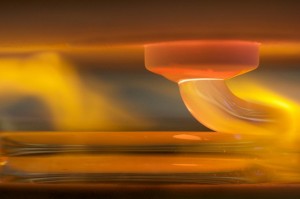Researchers have cracked the challenge of printing glass through a nozzle. A team of MIT researchers have opened up a new frontier in 3-D printing which is the ability to print optically transparent glass objects.
They demonstrated the first-ever machine that can print molten glass through a nozzle and make transparent glass objects layer by layer according to digital instructions.
The 3-D printer G3DP produces optically transparent glass with the push of a button and contains a “kiln cartridge” that heats up the material at an incredible 1,900 degrees until it is molten.
It’s already possible to use tiny granules of glass in a powder bed with conventional 3-D printing techniques like jetting and sintering, but the products turn out opaque.
The most challenging aspect of printing glass is that it must happen at extremely high temperatures. To flow well enough to be extruded through a nozzle, the material must be kept at a temperature greater than 1000 °C.
To achieve this, the printer needs separate heating systems for each stage of the manufacturing process.
The molten glass ink is housed in a crucible above the nozzle, where heating coils maintain the desired temperature.
The glass flows from the crucible into a custom nozzle, where separate heating coils keep it hot enough to flow and without sticking to the inside.
Finally, objects are built inside a third heating chamber, which is kept just above the temperature at which the glass turns solid.
This allows the printed objects to be cooled in a gradual, controlled way so that they don’t break.
The machine creates objects by methodically laying down transparent layers of glass that look like instantly hardening honey.
Glass is inherently a very difficult material to work with as its viscosity changes with temperature, requiring precise control of temperature at all stages of the process.
The high-temperature system developed by the MIT team helps produce printed glass objects that are both strong and fully transparent to light thus retaining its properties.
Like other 3-D printers now on the market, the device can print designs created in a computer-assisted design program, producing a finished product with little human intervention.
The new process could allow unprecedented control over the glass shapes that can be produced and this can help design and print components with variable thicknesses and complex inner features.
For more information please visit: www.mit.edu


Comments are closed.